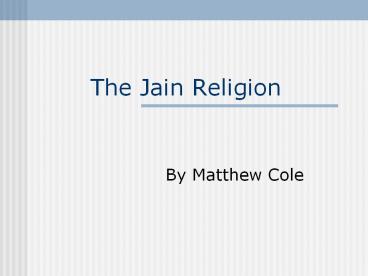The Jain Religion - PowerPoint PPT Presentation
1 / 12
Title:
The Jain Religion
Description:
The Jain Religion By Matthew Cole – PowerPoint PPT presentation
Number of Views:192
Avg rating:3.0/5.0
Title: The Jain Religion
1
The Jain Religion
- By Matthew Cole
2
History of Jainism
- Originating on the Indian subcontinent, Jainism
or The Jain Dharma. Is one of the oldest
religions of its homeland and indeed of the
world. Jainism has prehistoric origins dating
before 3000 BC, and before the beginning of
Indo-Aryan culture. - Jain religion is unique in that, during its
existence of over 5000 years, it has never
compromised on the concept of nonviolence either
in principle or practice.
3
History of Jainism
- Jainism traces its roots from a chain of 24 Jinas
("those who overcome", or conqueror) in ancient
East India. The first Jina is traditionally
believed to have been a giant who lived 8.5
million years ago. The most recent and last Jina
was Mahavira. He was born in 550 BCE and was the
founder of the Jain community. He attained
enlightenment after 13 years of deprivation. - Jainism is a new religious movement , which
contains many elements similar to Hinduism and
Buddhism. The world's almost 4 million Jains are
almost entirely located in India.
4
What is Jainism?
- Jainism believes that the universe and all its
substances are everlasting. It has no beginning
or end with respect to time. There is no need of
some one to create or manage the affairs of the
universe. The universe is run on its own
according to its own cosmic laws. Hence Jainism
does not believe in God as a creator, survivor,
and destroyer of the universe.
5
Jainism
- However Jainism does believe in God. When a
living being destroys all his karmas, he
possesses perfect knowledge, vision, power, and
bliss. This living being is a God of the Jain
religion. Hence Jains do not believe in one God.
Gods in the Jain religion are countless and the
number is continuously increasing as more living
beings attain freedom. Every living being has a
potential to become a God of the Jain religion.
6
Eight types of Karmas
- The first Four
- Delusion
- Knowledge
- Vision
- Natural traits
- The last Four
- Body
- Life span
- Social Standing
- Pleasure Pain of the body
7
Five Great Vows
- Non-violence (Ahimsa)
- Truth (Satya)
- Non-stealing (Achaurya)
- Celibacy (Brahmacharya)
- Non-possession (Aparigraha)
- /Non-attachment
8
Jainism Symbol
9
Jain Holidays
- There are three main holidays in Jainism Rakhi,
Dusserah, also called Durja Puja, and Diwali. The
Hindus celebrate the same holidays, but the Jains
have some differences in their celebrations.
Because the Jains use the Hindu calendar, the
dates of these holidays varies.
10
Rakhi
- To celebrate Rakhi, women make amulets and give
them to their loved ones, including brothers and
husbands, to protect them from evil.
11
Dusserah
- Dusserah, which is called Durja Puja in some
parts of India, also involves the triumph of good
over evil. Legend tells of the defeat of the evil
demon Ravana by Rama, who worshiped the goddess
Durja. The ten day festival includes
re-enactments of this battle, as well as
ceremonies where people forgive their neighbors,
friends, and family members for any wrongdoings
during the past year.
12
Diwali
- Diwali is the Jain new year. The Jains believe
this is when their last great saint, Mahavira,
died. The first two days of the celebration are
similar to the Hindu celebration, where special
prayers and ceremonies are held, and children are
given candy and treats. On the third day, the
Jains believe they must settle all their accounts
and pay all their bills from the previous year.
If this is done, there is a special ceremony
involving the family's accounting book. On the
fourth day, the Jains visit their friends,
family, and neighbors to celebrate the new year.
Throughout the celebration, candles and lanterns
are lit to honor Mahavira, which is why this
holiday is also called the Festival of Lights.

